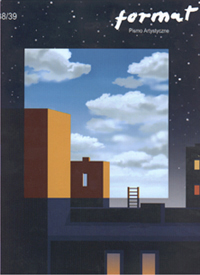Drzwi do duszy (w obrazowaniu Stanisława Fijałkowskiego)
A Door to the Human Soul. On Stanisław Fijałkowski’s Images
Author(s): Zofia GebhardSubject(s): Fine Arts / Performing Arts
Published by: Akademia Sztuk Pięknych im. Eugeniusza Gepperta we Wrocławiu
Keywords: Stanisław Fijałkowski’s paintings; Strzemiński; Kandinsky; Malewicz; contemporary art
Summary/Abstract: Stanisław Fijałkowski’s paintings can be considered in the context of “surface and symbols”. He knows how to paint depth, how to make the eyes rest, and how to stop the time flow. Through a widow in his picture, one can see what is not visible. I like his pictures, because they open the door to the human soul. Fijałkowski reduces formal elements, such as colour, signs, and anecdotes. He simplifies arrangements, and transforms objects in order to reveal their hidden meaning. He reads the script of the reality, and we can follow him, when he interprets it to us. He is a master-interpreter. He contemplates and teaches us how to contemplate his art. He believes that painters become effective when they are able to concentrate, and appeal to people’s emotions. He likes glazing and mat effects. His palette includes such colours as the brown, green, and ochre. The colours vibrate on the surface of his canvases. Through the cracks in paint, we can see the layers of different paint. The artist uses tonal and textural differences in order to produce the illusion of space. His pictures don’t have surface, they contain space. Fijałkowski studied with Strzemiński, and he interprets Kandinsky and Malewicz. He believes in harmony and harmonious construction. He likes to synthesise and verbalise what he imagines. He likes metaphors. His pictures can be compared with musical compositions, and not with literary writing. He likes metaphysical musing. He is an intuitive painter who believes in spiritual energy. Fijałkowski’s pictures are either dynamic or peaceful. He paints as if he fought with the matter of his canvases. And, after winning the fight, he meditates, becomes calm. His emotions are clear and dramatic. The titles of his pictures are like opening lines of poems (‘Remembre Beethoven’s “Allegro Con Bisso”’, ‘Sudden Appearance of Beatrice’)
Journal: Format - Pismo artystyczne
- Issue Year: 43/2003
- Issue No: 03+04
- Page Range: 034-035
- Page Count: 2
- Language: Polish

